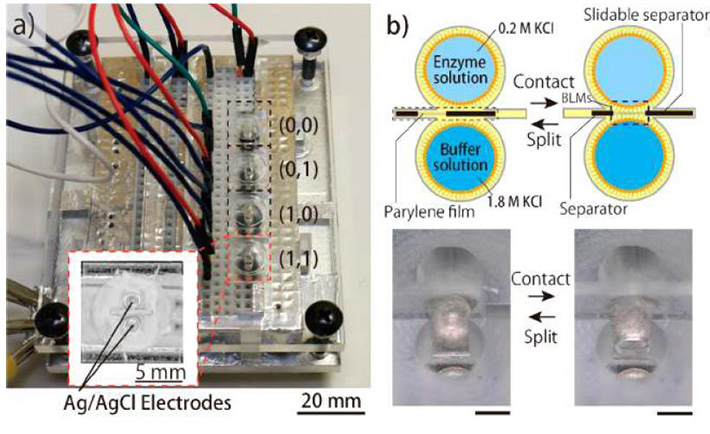A group of Associate Professor Ryuji Kawano of Tokyo University of Agriculture and Technology, Division of Biotechnology and Life Science, Institute of Engineering, and Associate Professor Masahiro Takinoue of Tokyo Institute of Technology, School of Computing succeeded in detecting output molecules that are the calculation results of DNA computing using DNA molecules as electric information through a nanopore1 membrane protein (Figure 1).
Figure 1. DNA computing molecules are detected by nanopore proteins reconstituted in artificial cell membranes. Input DNA molecules were converted and output as RNA molecules, and then the RNA molecule information passing through the nanopore was extracted electrically.
Computers that we use everyday and engineering robots that incorporate these perform binary numerical calculation information processing using electrons as information media. On the other hand, molecular robots2 aim to perform information processing using binary numbers or more sophisticated computations using molecules (DNA/RNA) as information media. In this research, they performed "AND" AND operation3, which is a binary number, through DNA computing. We converted and output DNA as an input molecule to RNA and successfully detected the output RNA using electrochemical measurement via a nanopore. This makes it possible to retrieve output molecules as information in a shorter time than with conventional methods. In addition, because it is possible to convert molecular information into electric information, the results lead to the integration of molecular robots and electronic devices.
In the future, it is expected to be applied to systems that can diagnose and treat diseases in the body by constructing molecular robots with advanced functions.
This research result was published on the online edition of ACS Synthetic Biology on April 17.
Research highlights
- Successful computation using DNA in artificial cells covered with lipid molecules, which are cell membrane components
- An AND operation, which is a type of logic gate, was performed to convert the input DNA molecule and output it as RNA
- Output RNA molecule information could be extracted as an electric signal through electric current measurement using a nanopore
Figure 2. Micro-device used for DNA computing and nanopore measurement. A droplet was created as an artificial cell membrane model in the device, and DNA computing and nanopore measurement were successfully performed at the same time in the droplet.
1 Nanopore
Nano-sized pore, about 1.4 nm in diameter forms in the cell membrane by membrane proteins and ion channels.
2 Molecular robot
Molecules are systemized through the introduction of robot engineering methodology, and it is a programmable artificial molecular system with advanced "senses," "intelligence," and "motion."
3 AND operation
A circuit that outputs "1" as a calculation result only when all of the input signals are true "1" at one of the logic gates. It is included in IC chips, etc., and becomes a basic element when the device calculates.
Reference
Authors: |
Masayuki Ohara1, Masahiro Takinoue2, Ryuji Kawano1* |
Title of original paper: |
Nanopore Logic Operation with DNA to RNA Transcription in a Droplet System |
Journal: |
ACS Synthetic Biology (April 17, 2017 in the online edition) |
DOI : |
|
Affiliations : |
1Division of Biotechnology and Life Science, Institute of Engineering, Tokyo University of Agriculture and Technology (TUAT)
2Department of Computer Science, Tokyo Institute of Technology |
. Any information published on this site will be valid in relation to Science Tokyo.





